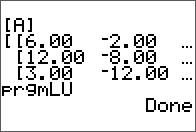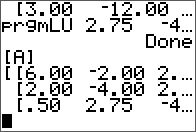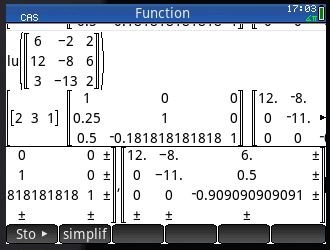As an extension to a previous entry on doing LU decomposition in Nspire and R, the TI-84 is covered here. There is no built-in function like in the Nspire for this, but there are many programs available online, with most of them employing a simple Doolittle algorithm without pivoting.
The non-pivoting program described here for the TI-84 series is with a twist. No separate L and U matrix variables are used and the calculations are done in place with the original input matrix A. The end result of both L and U are also stored in this input matrix. This is made possible by the property of the L and U matrices in this decomposition are triangular. Therefore, at the little price of some mental interpretation of the program output, this program will take up less memory and run a little faster than most simple LU decomposition programs online for the same class of calculator. From a simple benchmark with a 5 x 5 matrix, this program took 2 seconds while another standard program took 2.7 seconds.
The input matrix A.

Results are stored in the same matrix.

L, U, and verification.







